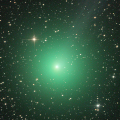
|
Now it is so bright as 4.0 mag (Jan. 17, Marco Goiato). It is visible with naked eyes. In the Northern Hemisphere, it keeps observable in good condition after this until the comet fades out. In the Southern Hemisphere, it is observable only until late January.
Date(TT) R.A. (2000) Decl. Delta r Elong. m1 Best Time(A, h)
Jan. 17 3 19.67 18 31.1 0.529 1.305 116 4.4 20:57 (156, 32)
Jan. 24 2 46.36 30 15.5 0.629 1.294 104 4.7 20:51 (149, 16)
|
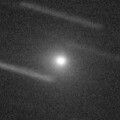
|
It brightened very rapidly in outburst up to 8.8 mag in mid December (Dec. 19, Marco Goiato). Then it faded down to 10.7 mag (Jan. 14, Chris Wyatt). However, it brightened in outburst again on Jan. 16, and brightened up to 7.0 mag (Jan. 17, Maik Meyer). In the Northern Hemisphere, it will be geting higher gradually. In the Southern Hemisphere, it keeps locating extremely low after this.
Date(TT) R.A. (2000) Decl. Delta r Elong. m1 Best Time(A, h)
Jan. 17 22 57.34 -5 18.2 1.393 1.023 47 9.9 20:57 ( 88, 6)
Jan. 24 23 28.20 -1 15.4 1.405 1.058 48 10.0 20:51 ( 93, 6)
|
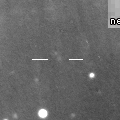
|
Now it is 15.1 mag (Dec. 16, Ken-ichi Kadota). It will brighten up to 8-9 mag in 2015 spring. In the Southern Hemisphere, it will be getting higher gradually after this. In the Northern Hemisphere, it keeps extremely low and hard to observe until June. It will be observable in good condition after June while the comet will be fading gradually.
Date(TT) R.A. (2000) Decl. Delta r Elong. m1 Best Time(A, h)
Jan. 17 17 13.58 -23 3.8 2.277 1.604 36 11.4 3:21 (290, 11)
Jan. 24 17 37.20 -23 36.3 2.210 1.567 38 11.1 3:31 (289, 14)
|
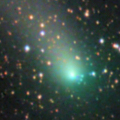
|
The brightness evolution has slowed down before the perihelion passage, and it faded down to 11.6 mag in late October (Oct. 26, Todd Augustyniak). However, an outburst occured around Nov. 10-12, and it brightened by 2 mag. It is bright as 10.4 mag still now (Nov. 29, Seiichi Yoshida). In the Northern Hemisphere, it is getting higher rapidly in the morning sky, and it will be observable in excellent condition after this while the comet will be fading. In the Southern Hemisphere, it is not observable until mid February.
Date(TT) R.A. (2000) Decl. Delta r Elong. m1 Best Time(A, h)
Jan. 17 18 3.17 6 21.3 2.500 1.834 38 11.1 3:21 (273,-16)
Jan. 24 18 4.64 8 57.8 2.471 1.896 44 11.2 3:31 (266,-10)
|

|
It brightened up to 6.9 mag in autumn (Oct. 17, Marco Goiato). Now it is fading. But it is bright as 12.1 mag still now (Jan. 14, Chris Wyatt). In the Northern Hemisphere, it keeps observable in the evening low sky until early February. It is getting lower also in the Southern Hemisphere, and will be unobservable temporarily in March. But it will be observable in good condition again after April.
Date(TT) R.A. (2000) Decl. Delta r Elong. m1 Best Time(A, h)
Jan. 17 0 7.22 -29 2.4 2.769 2.388 57 11.2 20:57 ( 75, 32)
Jan. 24 0 8.23 -27 23.5 2.954 2.471 51 11.4 20:51 ( 75, 27)
|
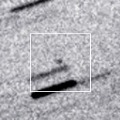
|
Now it is 16.0 mag (Dec. 22, Ken-ichi Kadota). It will brighten very rapidly, and will brighten up to 11 mag from January to February. In the Southern Hemisphere, it will be observable in the morning sky after February while the comet will be fading. It is hardly observable in the Northern Hemisphere.
Date(TT) R.A. (2000) Decl. Delta r Elong. m1 Best Time(A, h)
Jan. 17 18 13.39 -18 58.9 2.089 1.250 23 12.0 3:21 (295, -2)
Jan. 24 18 41.09 -20 3.5 2.075 1.242 23 11.8 3:31 (295, 0)
|
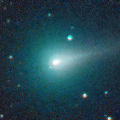
|
Now it is so bright as 10.9 mag (Dec. 20, Marek Biely). It will be fading graudually after this. But it keeps observable for a long time until the comet fades out.
Date(TT) R.A. (2000) Decl. Delta r Elong. m1 Best Time(A, h)
Jan. 17 15 52.42 -11 46.8 1.875 1.594 58 12.8 3:21 (270, 22)
Jan. 24 16 9.25 -12 31.4 1.882 1.649 61 13.1 3:31 (267, 26)
|
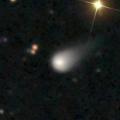
|
Now it is 13.6 mag (Dec. 19, Chris Wyatt). Getting brighter than originally expected, and it is already visible visually. It is expected to brighten up to 4 mag from autumn to winter in 2015. It will be unobservable soon. In the Southern Hemisphere, it will be observable in good condition again after late March. In the Northern Hemisphere, it is hardly observable until 2015 December.
Date(TT) R.A. (2000) Decl. Delta r Elong. m1 Best Time(A, h)
Jan. 17 22 29.43 -24 6.6 5.045 4.290 36 13.3 20:57 ( 68, 11)
Jan. 24 22 32.31 -23 48.5 5.036 4.215 30 13.3 20:51 ( 66, 7)
|
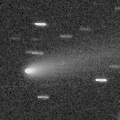
|
Now it is 13.8 mag (Dec. 29, Chris Wyatt). It is fainter than originally predicted by 2 mag. In the Northern Hemisphere, it keeps observable at 14 mag in excellent condition from 2014 summer to 2015 spring. It locates somewhat low in the Southern Hemisphere.
Date(TT) R.A. (2000) Decl. Delta r Elong. m1 Best Time(A, h)
Jan. 17 11 51.32 17 14.9 1.453 2.162 123 13.8 3:21 (194, 37)
Jan. 24 11 53.27 17 37.7 1.416 2.186 130 13.8 3:31 (183, 37)
|

|
It is getting higher gradually in the morning sky.
Date(TT) R.A. (2000) Decl. Delta r Elong. m1 Best Time(A, h)
Jan. 17 17 16.56 -30 6.6 6.841 6.077 36 14.1 3:21 (297, 15)
Jan. 24 17 22.15 -30 14.0 6.769 6.075 42 14.0 3:31 (293, 20)
|
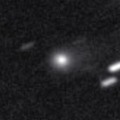
|
It is getting higher gradually in the morning sky. In 2015, it keeps 13 mag and will be observable in good condition for a long time.
Date(TT) R.A. (2000) Decl. Delta r Elong. m1 Best Time(A, h)
Jan. 17 17 23.37 -13 48.3 4.278 3.534 36 14.1 3:21 (284, 4)
Jan. 24 17 33.84 -13 48.7 4.207 3.522 40 14.1 3:31 (280, 9)
|
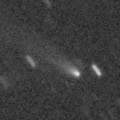
|
Now it is 14.8 mag (Dec. 12, Mike Wolle). It will be observable at 14 mag in excellent condition in winter.
Date(TT) R.A. (2000) Decl. Delta r Elong. m1 Best Time(A, h)
Jan. 17 0 51.97 9 45.0 1.107 1.339 79 14.6 20:57 (118, 20)
Jan. 24 1 13.39 12 36.6 1.136 1.344 78 14.7 20:51 (120, 18)
|
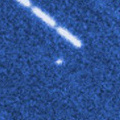
|
Now it is 16.2 mag (Dec. 12, Taras Prystavski). It will brighten up to 9 mag in 2015 spring. But the condition of this apparition is bad. It will be getting lower gradually, and will be unobservable in late January in the Northern Hemisphere, or in mid March in the Southern Hemisphere. In the Northern Hemisphere, it will be observable after 2015 autumn while the comet will be fading.
Date(TT) R.A. (2000) Decl. Delta r Elong. m1 Best Time(A, h)
Jan. 17 22 46.78 -31 58.9 2.625 1.977 40 15.0 20:57 ( 64, 18)
Jan. 24 23 2.06 -29 51.9 2.614 1.927 37 14.7 20:51 ( 65, 16)
|
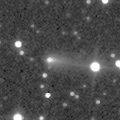
|
Now it is 14.2 mag (Dec. 20, Taras Prystavski). It keeps 15 mag until February, and it will be observable in excellent condition in the Northern Hemisphere. It locates somewhat low in the Southern Hemisphere.
Date(TT) R.A. (2000) Decl. Delta r Elong. m1 Best Time(A, h)
Jan. 17 6 28.96 24 25.4 1.534 2.482 160 14.9 22:42 (180, 31)
Jan. 24 6 24.46 23 47.9 1.573 2.486 152 15.0 22:10 (180, 31)
|
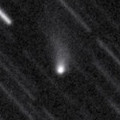
|
Now it is 15.6 mag (Dec. 12, Taras Prystavski). The brightness evolution is somewhat slow. It keeps 15-16 mag for a long time from 2014 autumn to 2015 autumn. In the Southern Hemisphere, it keeps observable in excellent condition for a long time. In the Northern Hemisphere, it is unobservable until 2015 June.
Date(TT) R.A. (2000) Decl. Delta r Elong. m1 Best Time(A, h)
Jan. 17 1 44.85 -66 47.3 2.183 2.065 70 15.1 20:57 ( 26, 49)
Jan. 24 1 22.53 -62 16.7 2.240 2.046 65 15.1 20:51 ( 34, 46)
|
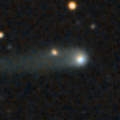
|
Now it is 14.5 mag (Dec. 24, Taras Prystavski). It keeps 15 mag for a long time from 2014 to 2015. It is observable in excellent condition in 2014 in the Southern Hemisphere, or in 2015 in the Northern Hemisphere.
Date(TT) R.A. (2000) Decl. Delta r Elong. m1 Best Time(A, h)
Jan. 17 0 16.46 -12 39.5 4.257 3.912 63 15.1 20:57 ( 93, 26)
Jan. 24 0 19.56 -10 55.3 4.346 3.905 57 15.1 20:51 ( 92, 21)
|

|
It brightened up to 11-12 mag in 2012. It has already faded down to 15.5 mag (Dec. 24, Taras Prystavski). It keeps observable at 15 mag in good condition until 2015 summer.
Date(TT) R.A. (2000) Decl. Delta r Elong. m1 Best Time(A, h)
Jan. 17 12 1.19 -10 30.1 8.430 8.839 111 15.1 3:21 (211, 62)
Jan. 24 11 58.38 -10 23.8 8.354 8.876 119 15.1 3:31 (190, 65)
|
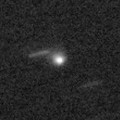
|
It will approach to the sun down to 0.3 a.u. in 2015 July, and it is expected to be bright. Now it is 15.3 mag (Dec. 20, Taras Prystavski). It keeps observable while the comet will be brightening gradually until January when the comet will be 15 mag. The condition is bad after that and it will be hard to observe. But in the Southern Hemisphere, it will be observable after mid July in 2015, and keeps observable while the comet will be fading gradually. In the Northern Hemisphere, it is extremely hard to observe after 2015.
Date(TT) R.A. (2000) Decl. Delta r Elong. m1 Best Time(A, h)
Jan. 17 23 1.93 -20 0.1 3.730 3.099 44 15.3 20:57 ( 76, 15)
Jan. 24 23 6.81 -18 49.1 3.712 3.006 38 15.1 20:51 ( 75, 11)
|
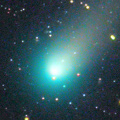
|
It brightened rapidly in outburst in mid October in 2013. Now it is fading. It has already faded down to 13.6 mag (Dec. 12, Taras Prystavski). In the Southern Hemisphere, it will be low temprarily from February to March. But it keeps observable in good condition for a long time after this until the comet fades out. It is not observable in the Northern Hemisphere.
Date(TT) R.A. (2000) Decl. Delta r Elong. m1 Best Time(A, h)
Jan. 17 23 4.48 -39 5.6 4.844 4.201 44 15.2 20:57 ( 59, 25)
Jan. 24 23 12.72 -38 17.8 4.956 4.265 41 15.4 20:51 ( 58, 22)
|

|
Now it is 15.2 mag (Dec. 28, Taras Prystavski). It will brighten up to 14 mag from 2015 to 2016. It is observable in good condition in the Southern Hemisphere. It locates somewhat low in the Northern Hemisphere.
Date(TT) R.A. (2000) Decl. Delta r Elong. m1 Best Time(A, h)
Jan. 17 3 7.00 -18 29.8 4.339 4.607 99 15.3 20:57 (122, 63)
Jan. 24 3 1.53 -17 7.2 4.424 4.583 93 15.3 20:51 (115, 57)
|
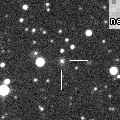
|
Now it is 15.5 mag (Dec. 13, Taras Prystavski). In the Northern Hemisphere, it keeps 15-16 mag and observable in excellent condition for a long time until early summer in 2015. It locates somewhat low in the Southern Hemisphere.
Date(TT) R.A. (2000) Decl. Delta r Elong. m1 Best Time(A, h)
Jan. 17 13 30.90 32 57.2 3.221 3.614 105 15.6 3:21 (211, 14)
Jan. 24 13 33.73 33 11.3 3.166 3.630 110 15.6 3:31 (204, 17)
|
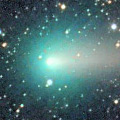
|
It brightened up to 6.5 mag in September (Sept. 21, Marco Goiato). Now it is fading. It has already faded down to 14.9 mag (Jan. 2, Taras Prystavski). It keeps observable in good condition after this, while the comet will be fading gradually.
Date(TT) R.A. (2000) Decl. Delta r Elong. m1 Best Time(A, h)
Jan. 17 16 1.35 -0 6.0 2.393 2.088 60 15.6 3:21 (261, 13)
Jan. 24 15 59.30 1 38.6 2.355 2.186 67 15.8 3:31 (253, 20)
|
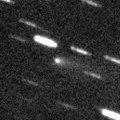
|
Now it is 15.1 mag (Dec. 30, Mitsunori Tsumura). It keeps observable for a long time after this while the comet will be fading gradually.
Date(TT) R.A. (2000) Decl. Delta r Elong. m1 Best Time(A, h)
Jan. 17 9 51.01 0 30.9 1.821 2.685 144 15.8 2:08 (180, 55)
Jan. 24 9 45.76 0 56.7 1.816 2.728 152 15.9 1:35 (180, 54)
|
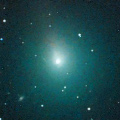
|
It brightened rapidly, and reached up to 10.3 mag in autumn (Oct. 22, Bob King). Now it is fading rapidly. It has already faded down to 13.9 mag (Dec. 9, Mitsunori Tsumura). In the Northern Hemisphere, it keeps observable in good condition until the comet fades out in spring. It is not observable in the Southern Hemisphere.
Date(TT) R.A. (2000) Decl. Delta r Elong. m1 Best Time(A, h)
Jan. 17 19 25.98 43 32.0 2.001 1.814 64 15.9 3:21 (241,-48)
Jan. 24 19 30.53 42 42.3 2.074 1.853 63 16.6 3:31 (241,-42)
|
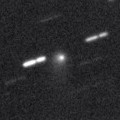
|
Now it is 15.7 mag (Dec. 20, Taras Prystavski). It keeps observable at 15-16 mag for a long time from 2015 to 2016. In the Northern Hemisphere, it is observable in excellent condition. It locates somewhat low in the Southern Hemisphere.
Date(TT) R.A. (2000) Decl. Delta r Elong. m1 Best Time(A, h)
Jan. 17 2 58.09 28 12.6 5.086 5.551 113 16.0 20:57 (155, 22)
Jan. 24 2 56.41 28 36.5 5.177 5.533 106 16.0 20:51 (150, 19)
|
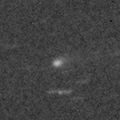
|
Now it is 16.3 mag (Dec. 20, Taras Prystavski). It will brighten up to 16 mag and will be observable in excellent condition in winter.
Date(TT) R.A. (2000) Decl. Delta r Elong. m1 Best Time(A, h)
Jan. 17 12 13.77 4 37.9 1.520 2.130 114 16.0 3:21 (206, 47)
Jan. 24 12 17.94 4 49.3 1.469 2.149 121 16.0 3:31 (194, 49)
|
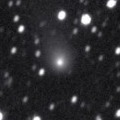
|
Now it is 15.3 mag (Dec. 19, Taras Prystavski). It is already unobservable in the Southern Hemisphere. It will be unobservable in mid February also in the Northern Hemisphere. But it will be observable again at 17 mag from summer to autumn. The fragment B is still visible at 18.3 mag (Dec. 31, E. Bryssinck).
Date(TT) R.A. (2000) Decl. Delta r Elong. m1 Best Time(A, h)
Jan. 17 22 49.53 16 6.5 5.355 4.888 56 16.0 20:57 (104, -8)
Jan. 24 22 53.07 15 29.2 5.493 4.930 50 16.1 20:51 (101,-11)
|
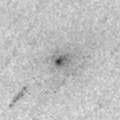
|
Now it is 15.4 mag (Nov. 19, Taras Prystavski). Extremely diffuse. It will be fading after this, and will be fainter than 18 mag in late March. It keeps observable in excellent condition in the Southern Hemisphere. But it locates low in the Northern Hemisphere.
Date(TT) R.A. (2000) Decl. Delta r Elong. m1 Best Time(A, h)
Jan. 17 9 18.84 -33 0.6 1.429 2.125 122 16.0 1:36 (180, 88)
Jan. 24 9 9.94 -35 20.1 1.459 2.170 124 16.2 1:00 ( 0, 90)
|
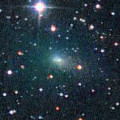
|
Now it is 13.8 mag (Dec. 20, Taras Prystavski). It keeps observable in excellent condition in the Northern Hemisphere. But it will be fading after this. It locates low in the Southern Hemisphere.
Date(TT) R.A. (2000) Decl. Delta r Elong. m1 Best Time(A, h)
Jan. 17 5 1.01 39 21.0 1.060 1.914 138 16.2 21:15 (180, 16)
Jan. 24 5 3.98 39 23.8 1.134 1.944 132 16.5 20:51 (180, 16)
|

|
Now it is 15.8 mag (Dec. 19, Taras Prystavski). It will pass close to the earth from spring to summer in 2016, and it is expected to be observable at 6-7 mag in good condition. In the Northern Hemispehre, it keeps observable in good condition until 2015 spring when the comet will brighten up to 15.5 mag. In the Southern Hemisphere, it keeps low for a long time until 2016 spring.
Date(TT) R.A. (2000) Decl. Delta r Elong. m1 Best Time(A, h)
Jan. 17 5 29.90 36 37.6 4.705 5.540 145 16.3 21:43 (180, 18)
Jan. 24 5 21.50 36 25.5 4.717 5.477 136 16.3 21:07 (180, 19)
|
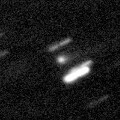
|
Now it is 16.6 mag (Dec. 27, Takaaki Oribe). It will brighten up to 16 mag in winter, and will be observable in excellent condition.
Date(TT) R.A. (2000) Decl. Delta r Elong. m1 Best Time(A, h)
Jan. 17 8 12.57 12 54.8 3.121 4.095 170 16.3 0:30 (180, 42)
Jan. 24 8 8.72 13 1.2 3.120 4.099 172 16.3 23:54 (180, 42)
|
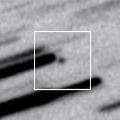
|
Now it is 15.3 mag (Nov. 27, Mt. Lemmon Survey). It will pass the perihelion on Mar. 15. In the Northern Hemispehre, it keeps observable in good condition until late February. In the Southern Hemisphere, it keeps observable until mid February, but it locates low.
Date(TT) R.A. (2000) Decl. Delta r Elong. m1 Best Time(A, h)
Jan. 17 1 22.25 15 21.6 0.845 1.279 88 16.3 20:57 (127, 21)
Jan. 24 1 15.97 12 46.1 0.869 1.181 78 16.4 20:51 (120, 18)
|

|
Now it is 17.8 mag (Dec. 29, K. Hills). It will brighten up to 13 mag in 2016. In the Northern Hemisphere, it will be observable in excellent condition in this winter. It locates somewhat low in the Southern Hemisphere. It is fainter than this ephemeris recently.
Date(TT) R.A. (2000) Decl. Delta r Elong. m1 Best Time(A, h)
Jan. 17 5 53.72 28 20.4 2.250 3.152 151 16.5 22:07 (180, 27)
Jan. 24 5 48.78 28 14.9 2.278 3.127 143 16.4 21:35 (180, 27)
|
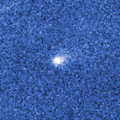
|
Now it is 15.6 mag (Dec. 20, Taras Prystavski). It will be higher gradually, and will be observable at 16-17 mag in good condition from winter to spring.
Date(TT) R.A. (2000) Decl. Delta r Elong. m1 Best Time(A, h)
Jan. 17 15 51.48 -10 17.4 2.238 1.924 58 16.5 3:21 (268, 21)
Jan. 24 16 6.94 -10 41.3 2.203 1.948 62 16.6 3:31 (265, 26)
|

|
Now it is 17.9 mag (Dec. 30, Catalina Sky Survey). It will brighten up to 11 mag in 2015 autumn. In this apparition, it is observable until the highlight while the comet is brightening.
Date(TT) R.A. (2000) Decl. Delta r Elong. m1 Best Time(A, h)
Jan. 17 13 2.19 -1 51.1 2.552 2.909 101 17.1 3:21 (226, 47)
Jan. 24 13 6.40 -2 0.8 2.417 2.868 107 16.8 3:31 (216, 52)
|
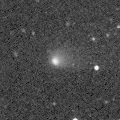
|
It brightened up to 13.7 mag in autumn (Sept. 16, Taras Prystavski). Now it is fading. But it is bright as 15.9 mag still now (Dec. 20, Taras Prystavski). It keeps observable until March when it becomes fainter than 18 mag.
Date(TT) R.A. (2000) Decl. Delta r Elong. m1 Best Time(A, h)
Jan. 17 0 43.44 -6 30.4 2.605 2.473 71 16.9 20:57 (103, 28)
Jan. 24 0 53.49 -5 15.9 2.702 2.491 67 17.1 20:51 (102, 25)
|
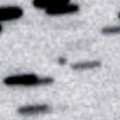
|
Now it is 16.0 mag (Jan. 3, Taras Prystavski). It keeps 17-18 mag for a long time from 2014 to 2016.
Date(TT) R.A. (2000) Decl. Delta r Elong. m1 Best Time(A, h)
Jan. 17 13 11.69 -22 43.7 5.228 5.338 91 17.1 3:21 (255, 60)
Jan. 24 13 7.22 -23 8.9 5.100 5.338 98 17.0 3:31 (243, 68)
|

|
Now it is 16.9 mag (Dec. 26, Taras Prystavski). It keeps 13 mag for a long time from 2015 to 2016, and will be observable in excellent condition in the Northern Hemisphere. In the Southern Hemisphere, it is observable only until mid 2015 March.
Date(TT) R.A. (2000) Decl. Delta r Elong. m1 Best Time(A, h)
Jan. 17 3 52.75 20 28.0 4.272 4.892 124 17.0 20:57 (166, 33)
Jan. 24 3 48.57 21 0.7 4.325 4.840 116 17.0 20:51 (159, 31)
|

|
First return of a peculiar asteroid 1998 HO121. It keeps observable at 17-18 mag from 2015 to 2016.
Date(TT) R.A. (2000) Decl. Delta r Elong. m1 Best Time(A, h)
Jan. 17 7 4.63 6 31.2 2.291 3.239 161 17.1 23:18 (180, 48)
Jan. 24 7 0.78 6 53.2 2.294 3.220 156 17.2 22:47 (180, 48)
|
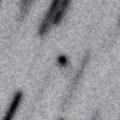
|
Now it is 16.7 mag (Dec. 13, Taras Prystavski). It keeps 17 mag until January, and it will be observable in excellent condition in the Northern Hemisphere.
Date(TT) R.A. (2000) Decl. Delta r Elong. m1 Best Time(A, h)
Jan. 17 4 44.53 52 37.0 1.006 1.818 131 17.2 20:59 (180, 2)
Jan. 24 4 46.72 53 36.4 1.057 1.823 126 17.3 20:51 (177, 1)
|
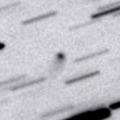
|
Now it is 16.9 mag (Oct. 30, Toshiyuki Takahashi). It keeps observable at 17-18 mag for a long time from 2013 to 2016. It keeps locating high in the Northern Hemisphere. It keeps locating very low in the Southern Hemipshere.
Date(TT) R.A. (2000) Decl. Delta r Elong. m1 Best Time(A, h)
Jan. 17 17 21.06 46 32.4 6.716 6.543 75 17.3 3:21 (230,-27)
Jan. 24 17 23.23 47 28.9 6.683 6.550 78 17.3 3:31 (227,-22)
|
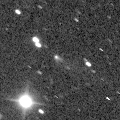
|
Now it is 18.1 mag (Dec. 26, D. Buczynski). It was observed at 17 mag from 2013 to early 2014. It will be observable at 17.5 mag in good condition again from autumn to winter in 2014. But recently, it is fainter than this ephemeris.
Date(TT) R.A. (2000) Decl. Delta r Elong. m1 Best Time(A, h)
Jan. 17 8 22.79 13 0.2 2.403 3.375 169 17.3 0:40 (180, 42)
Jan. 24 8 17.76 13 12.1 2.410 3.390 173 17.4 0:08 (180, 42)
|
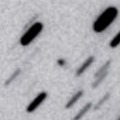
|
Now it is 17.8 mag (Dec. 30, G. Linan). It was observed around 17-18 mag in early 2014. It will be observable around 17-18 mag again from 2014 autumn to 2015 spring, in excellent condition in the Northern Hemisphere. It is not observable in the Southern Hemisphere.
Date(TT) R.A. (2000) Decl. Delta r Elong. m1 Best Time(A, h)
Jan. 17 10 50.35 56 52.6 4.449 5.155 131 17.4 3:07 (180, -2)
Jan. 24 10 45.89 57 7.9 4.430 5.162 133 17.4 2:36 (180, -2)
|
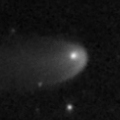
|
Now it is between 16.2 mag (Dec. 20, Taras Prystavski) and 20.5 mag (Dec. 20, B. Lutkenhoner). Extremely diffuse, and hard to observe.
Date(TT) R.A. (2000) Decl. Delta r Elong. m1 Best Time(A, h)
Jan. 17 3 8.42 -2 6.4 9.103 9.433 106 17.5 20:57 (141, 50)
Jan. 24 3 7.44 -1 39.7 9.250 9.469 99 17.5 20:51 (134, 47)
|

|
Now it is 17.9 mag (Dec. 29, Catalina Sky Survey). It keeps observable at 17 mag from winter to spring. It is observable in excellent condition in the Southern Hemisphere. But it locates somewhat low in the Northern Hemisphere.
Date(TT) R.A. (2000) Decl. Delta r Elong. m1 Best Time(A, h)
Jan. 17 11 52.16 -14 5.6 2.654 3.154 111 17.6 3:21 (210, 66)
Jan. 24 11 49.31 -16 11.1 2.557 3.143 118 17.5 3:31 (186, 71)
|
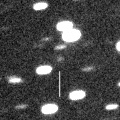
|
Now it is 18.3 mag (Dec. 20, S. Hellmich, S. Mottola, O. Tiefenbacher). Now it is around the aphelion. In the Northern Hemisphere, it is observable at 18 mag in good condition from winter to spring. It locates somewhat low in the Southern Hemisphere.
Date(TT) R.A. (2000) Decl. Delta r Elong. m1 Best Time(A, h)
Jan. 17 9 6.51 27 30.8 3.686 4.632 162 17.6 1:24 (180, 28)
Jan. 24 9 1.91 27 57.0 3.656 4.623 167 17.6 0:52 (180, 27)
|
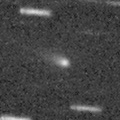
|
First return of a new periodic comet discovered in 2004. It brightened very rapidly as expected. Now it is 16.2 mag (Dec. 20, Taras Prystavski). It will be fading rapidly after this, and will be fainter than 18 mag in late January.
Date(TT) R.A. (2000) Decl. Delta r Elong. m1 Best Time(A, h)
Jan. 17 1 53.14 9 41.1 1.162 1.566 93 17.6 20:57 (130, 30)
Jan. 24 2 14.07 10 29.3 1.243 1.604 91 18.0 20:51 (131, 29)
|

|
It has not been observed in this apparition yet. It is expected to brighten rapidly and will be observable in good condition at 13 mag from March to May.
Date(TT) R.A. (2000) Decl. Delta r Elong. m1 Best Time(A, h)
Jan. 17 13 2.35 -7 42.8 1.160 1.634 99 18.1 3:21 (232, 52)
Jan. 24 13 20.52 -9 20.5 1.060 1.582 101 17.6 3:31 (227, 56)
|
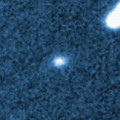
|
Now it is 16.7 mag (Dec. 22, Taras Prystavski). It keeps observable at 17 mag in good condition from winter to spring.
Date(TT) R.A. (2000) Decl. Delta r Elong. m1 Best Time(A, h)
Jan. 17 9 14.75 10 55.2 2.675 3.606 158 17.7 1:32 (180, 44)
Jan. 24 9 11.07 10 45.2 2.629 3.590 165 17.7 1:01 (180, 44)
|
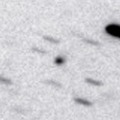
|
Now it is 17.8 mag (Jan. 7, Space Surveillance Telescope, Atom Site). It keeps 18 mag from 2014 to 2015. In 2015, it keeps observable in good condition from winter to spring.
Date(TT) R.A. (2000) Decl. Delta r Elong. m1 Best Time(A, h)
Jan. 17 10 58.54 -9 3.0 5.303 5.929 125 17.9 3:15 (180, 64)
Jan. 24 10 56.81 -9 30.8 5.230 5.938 132 17.8 2:46 (180, 65)
|
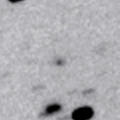
|
Now it is 18.8 mag (Dec. 20, K. Hills). It keeps 18 mag for a very long time from 2013 to 2018. It locates high in the Southern Hemisphere. But it locates somewhat low in the Northern Hemisphere.
Date(TT) R.A. (2000) Decl. Delta r Elong. m1 Best Time(A, h)
Jan. 17 12 23.09 -23 17.7 8.934 9.170 100 17.9 3:21 (241, 69)
Jan. 24 12 23.14 -23 30.1 8.824 9.168 107 17.9 3:31 (221, 75)
|
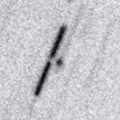
|
It was observed at 18 mag from spring to summer in 2014. In the Northern Hemisphere, it will be observable at 18 mag in good conditionn from winter to spring in 2015 again. It is not observable in the Southern Hemisphere.
Date(TT) R.A. (2000) Decl. Delta r Elong. m1 Best Time(A, h)
Jan. 17 15 38.42 47 9.4 4.222 4.316 88 18.0 3:21 (220,-12)
Jan. 24 15 39.58 49 24.4 4.155 4.318 92 17.9 3:31 (215, -9)
|
|
![]()
 40P/Vaisala 1
40P/Vaisala 1 22P/Kopff
22P/Kopff 284P/2013 J1 ( McNaught )
284P/2013 J1 ( McNaught ) C/2013 G9 ( Tenagra )
C/2013 G9 ( Tenagra ) C/2014 W2 ( PanSTARRS )
C/2014 W2 ( PanSTARRS ) (347449) 2012 TW236
(347449) 2012 TW236 P/2014 X1 ( Elenin )
P/2014 X1 ( Elenin ) C/2012 K8 ( Lemmon )
C/2012 K8 ( Lemmon ) 119P/Parker-Hartley
119P/Parker-Hartley C/2013 U2 ( Holvorcem )
C/2013 U2 ( Holvorcem ) C/2009 F4 ( McNaught )
C/2009 F4 ( McNaught ) C/2014 W6 ( Catalina )
C/2014 W6 ( Catalina ) 65P/Gunn
65P/Gunn 305P/2014 N1 ( Skiff )
305P/2014 N1 ( Skiff ) 218P/LINEAR
218P/LINEAR C/2014 W11 ( PanSTARRS )
C/2014 W11 ( PanSTARRS ) C/2013 TW5 ( Spacewatch )
C/2013 TW5 ( Spacewatch ) C/2013 C2 ( Tenagra )
C/2013 C2 ( Tenagra ) C/2014 F2 ( Tenagra )
C/2014 F2 ( Tenagra )![]()














































